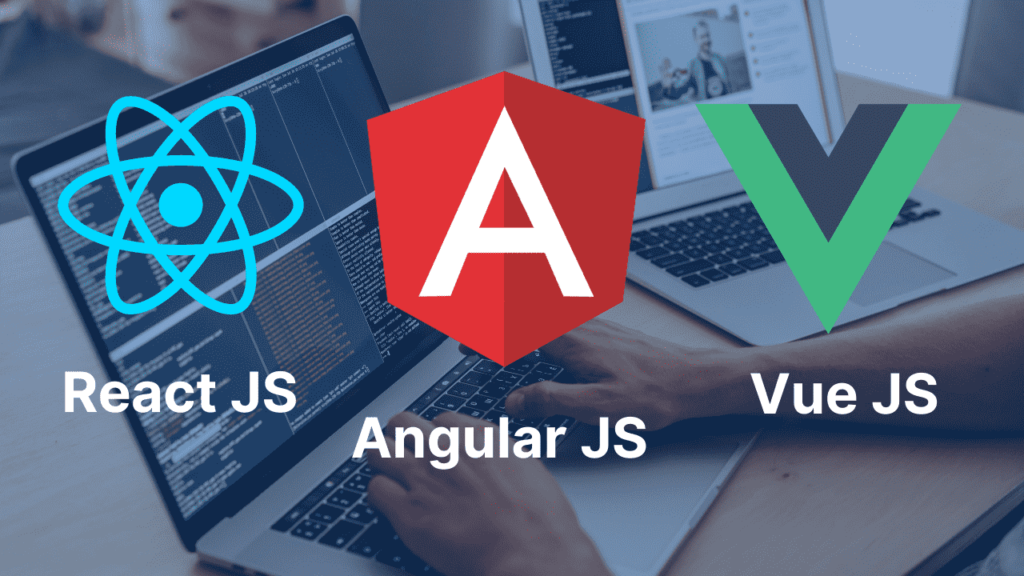Selecting the most suitable frontend framework for your project is a pivotal decision in web development. React, Angular, and Vue.js are three prominent contenders, each with its unique characteristics and ideal use cases. In this blog post, we will conduct a thorough examination of these frameworks, providing in-depth insights into their features, advantages, and scenarios where they excel.

React
React, developed and maintained by Facebook, is a JavaScript library for building user interfaces. It utilizes a declarative approach, allowing developers to create reusable UI components. These components update dynamically in response to changes in the underlying data, enabling the creation of highly interactive and responsive web applications.
Why Use React?
React’s strengths lie in its:
Component-Based Architecture:
React follows a component-based architecture, where UI elements are encapsulated as individual, reusable components. This promotes code reusability, maintainability, and modularity.
Virtual DOM:
React employs a virtual DOM, which optimizes rendering by only updating the parts of the page that have changed. This results in faster performance and a smoother user experience.
Large Community and Ecosystem:
React enjoys a vast and active community, which has contributed to a rich ecosystem of libraries, tools, and resources. This extensive support network is invaluable for developers seeking solutions and best practices.
When to Use React
Single-Page Applications (SPAs): React excels in building SPAs where dynamic content updates and seamless user interactions are crucial. Its virtual DOM and component-based structure facilitate the development of highly interactive interfaces.
Highly Interactive UIs: When an application requires a highly interactive and real-time user experience, React’s capabilities are well-suited to meet these demands. Its efficient rendering process ensures optimal performance.
Large Scale Applications: React is an excellent choice for large, complex applications where code maintainability and scalability are critical factors. Its component-based structure allows for the efficient management of extensive codebases.
Angular
Angular, developed and maintained by Google, is a comprehensive, opinionated framework for building dynamic web applications. It offers a complete suite of tools for structuring, developing, and deploying web applications, making it particularly suitable for enterprise-level projects.
Why Use Angular?
Angular stands out for its:
Opinionated Framework:
Angular provides a predefined structure and a set of best practices, which can be particularly beneficial for large teams or projects with strict architectural requirements. This opinionated approach ensures consistency and maintainability.
Dependency Injection:
Angular incorporates a built-in dependency injection system, which facilitates code maintainability, testability, and reusability. This promotes clean, modular code design.
Powerful CLI (Command Line Interface):
Angular CLI streamlines the development process by automating tasks like project scaffolding, testing, and deployment. This significantly enhances developer productivity.
When to Use Angular:
Enterprise-Level Applications:
Angular excels in enterprise-scale applications where maintainability, scalability, and adherence to strict architectural guidelines are essential. Its comprehensive framework provides the necessary tools for handling complex projects.
Complex, Data-Driven UIs:
When an application relies heavily on complex data interactions, Angular’s robust features for data binding and form handling become invaluable. It provides powerful tools for managing and manipulating data.
Large Development Teams:
Angular’s opinionated structure and well-defined patterns are advantageous for large teams. They ensure consistency in code style and structure, which is crucial for collaboration on extensive projects.
Vue.js
Vue.js is a progressive JavaScript framework for building modern web applications. Developed by Evan You, it combines the best features of React and Angular, providing a flexible and approachable framework for developers.
Why Use Vue.js?
Vue.js is characterized by:
Ease of Learning and Integration:
Vue.js is known for its simplicity and ease of integration, making it an excellent choice for small to medium-sized projects. Its gentle learning curve allows developers to quickly become proficient.
Incremental Adoption:
Vue.js can be incrementally adopted into existing projects, allowing developers to introduce Vue components into specific parts of their application. This flexibility makes it a versatile choice for existing codebases.
Active Community and Documentation:
Vue.js benefits from a vibrant community and thorough documentation. This accessibility ensures that developers have access to a wealth of resources and solutions.
When to Use Vue.js
Rapid Prototyping and Small to Medium-Sized Projects:
Vue.js excels in scenarios where rapid development and simplicity are key. It’s an ideal choice for startups and smaller projects that require swift iteration and deployment.
Interactive User Interfaces:
If your application demands dynamic, interactive user interfaces, Vue.js’ reactivity system allows for seamless updates. This makes it particularly suitable for applications with real-time data updates.
Team Flexibility:
Vue.js offers a less opinionated structure compared to Angular, making it suitable for teams with diverse backgrounds and preferences. It allows developers to work in a manner that aligns with their individual coding styles.
Conclusion
Choosing between React, Angular, and Vue.js depends on the specific requirements and context of your project. Each framework offers distinct advantages and excels in different scenarios. By considering factors such as project size, complexity, team expertise, and architectural needs, you can make an informed decision that lays the groundwork for a successful web application.

Leave a Reply